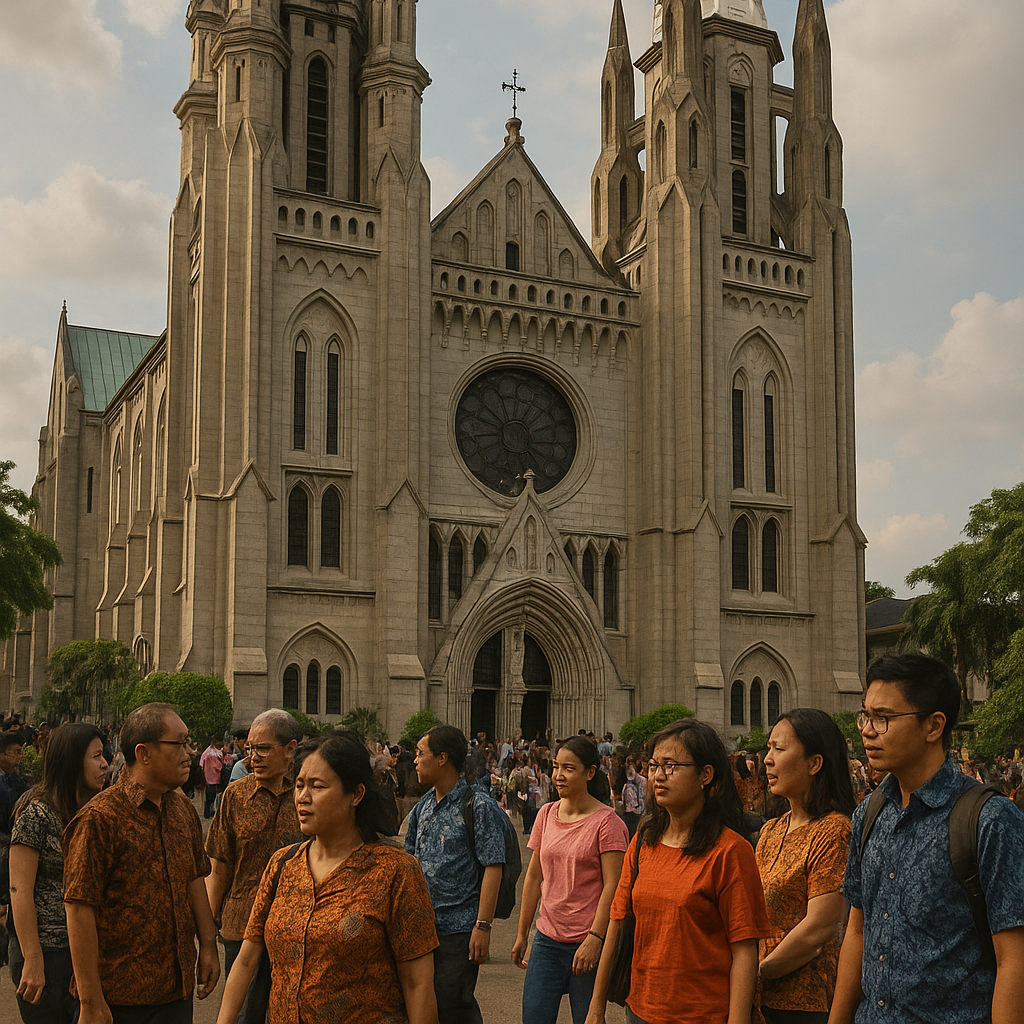The Catholic Church of Makassar Cathedral: History and Development
theolingua.id – The arrival of Catholicism in Makassar began in the 16th century with the entry of the Portuguese into the Nusantara region. The Portuguese brought the 3G motto: Gold (wealth), Glory (glory), and Gospel (spread of the Catholic religion). In 1525, three Portuguese missionaries, Father Antonio de Reis, Cosmas de Annuciacio, and Bernardino de Marvao, stopped in Makassar on their way to Maluku.
In 1537, two sons of the Kingdom of Gowa were baptised in Ternate and given the names Antonio and Miguel. Upon returning to Makassar, they introduced Catholicism to the local population, which then attracted the interest of many people.
A Portuguese merchant named Antonio de Payva came to Makassar in 1542. Apart from trading, he also helped spread the Catholic religion. Until 1548, a priest, Vicente Vegas, began to settle temporarily in Makassar.
The Initial Spread of Catholicism in Makassar
In 1544, a Portuguese merchant and missionary named Ruy Vas Pareira arrived in Makassar. His arrival was welcomed by Datu Suppa and Karaeng Siang because he was considered a trading partner. Over time, their relationship grew closer until finally the two kings were baptised with their families and attendants. Before the baptism, Antonio de Payva explained the Catholic teachings to the royal dignitaries.
According to the lontarak (traditional Malay manuscript) stored at Hasanuddin University (UNHAS), it is stated that ‘The priest succeeded in converting Datu Suppa, named Makeraiye, to Christianity, who later founded a church in the village of Maena. He also succeeded in converting Raja Bacukiki and Raja Siang in Pangkajene to Christianity.’
In 1545, Father Vicente Viegas came to Makassar and stayed for three years. He played an important role in the ministry of the Portuguese Catholics and some of the baptized aristocrats. The spread of Catholicism grew until finally four kings in South Sulawesi, namely Arung Alitta, Datu Suppa, Arung Bacukiki, and Karaeng Siang, converted to Catholicism.
The Period of Oppression and the Vacancy of Catholicism in Makassar
In 1633, when the Kingdom of Gowa-Tallo had officially become an Islamic kingdom, the King of Gowa still gave freedom to Catholics to worship and build churches. However, the situation changed drastically after the VOC conquered Gowa-Tallo in the Makassar War and forced Sultan Hasanuddin to sign the Bungaya Agreement on 18 November 1867.
One of the articles in the agreement stated that all Portuguese nationals must be expelled from Makassar. As a result, Catholic priests and missionaries were also expelled, and Catholics were forced to convert to Protestantism. For almost two centuries after this event, there were no records of the existence of a Catholic Church in Makassar.
The Establishment of the Makassar Cathedral Catholic Church
The re-emergence of Catholicism in Makassar occurred in 1898 with the establishment of the Makassar Cathedral Catholic Church, originally called Roomsch Katholieke Kerk. This church is the oldest Catholic church in South Sulawesi and is still in use today under the ownership of the Archdiocese of Makassar.
The construction of the church was led by a military engineer named Swartbol, in the Gothic architectural style. The construction was carried out by a Chinese contractor named Thio A Tek. Initially, the church had 20 small iron towers as ornaments on the edge of the roof. In 1923, a philanthropist named Mr Scharpff donated three bells which were later installed in a large iron tower south of the church.
On 30 April 1927, the bells arrived at the church along with statues of the Sacred Heart of Jesus, the Virgin Mary, and Saint Joseph. The bells were blessed on 3 July 1927 by the Apostolic Prefect.
The Cathedral Catholic Church during the Japanese Occupation
During the Japanese occupation, the Catholic Cathedral Church experienced great difficulties. All the priests and most of the monks and nuns were put in Japanese prison camps. Father Schneiders, who remained in Makassar, tried to save the mass equipment by burying the bottles of mass wine and storing the sacred items in a locked cupboard in the tabernacle.
In February 1942, after holding a service, Father Schneiders was arrested by Japanese soldiers and held captive until the end of the war. During the period 1942-1943, there was a leadership vacuum in the Cathedral Church. Worship did not resume until 3 April 1942, led by lay members Paulus Cerbonilla and Om Nani Fernandez.
On 9 October 1943, the city of Makassar was bombed by Allied forces. One of the bombs fell about 10 metres from the church, causing extensive damage, including the breaking of the glass behind the altar and the destruction of the church roof. As a result, the glass window that was previously at the back of the altar was turned into a wall without windows.
Development of the Post-Independence Cathedral Catholic Church
After Indonesia’s independence, the Cathedral Catholic Church grew again. As the number of Catholics in Makassar increased, the church underwent several renovations and developments. In 1933, a new church was built on Jalan Rajawali to accommodate the growing number of worshippers.
Until now, the Makassar Cathedral Catholic Church remains a religious centre and a symbol of the long history of the Catholic religion in South Sulawesi. With its high historical and architectural value, the church is not only a place of worship, but also a silent witness to the journey of the Catholic religion in Makassar from the 16th century to the modern era.
Such is the history of the Makassar Cathedral Catholic Church, which reflects the long journey of Catholicism from the arrival of the Portuguese to becoming part of the life of the people of South Sulawesi to the present day.







